Introduction
Ever dreamed of feeling like an ancient warrior or a modern-day Olympian? Archery offers both and more, blending history, skill, and adrenaline. If you’re an archery enthusiast, outdoor sports lover, or just starting your adventure with a bow and arrow, you’re in the right place. This comprehensive guide will walk you through everything you need to know about using a bow and arrow from its rich history to practical techniques you can master today.
A Brief Overview Of Archery
Archery has been around for thousands of years, dating back to ancient civilizations. Initially used for hunting and warfare, archery has evolved into a beloved sport and recreational activity. Today, it’s recognized worldwide, even taking part at the Olympic Games.
Historical Context And Significance
Archery’s historical roots run deep. Ancient Egyptians, Greeks, and Chinese civilizations all used bows and arrows for combat and hunting. Over time, archery became an essential skill for warriors and hunters alike. Fast forward to modern times, and archery is predominantly a sport that tests your skill, focus, and precision.
Benefits Of Archery As A Sport And Hobby
Archery isn’t just a fun way to pass the time; it offers numerous physical and mental benefits. Physically, it enhances strength, hand-eye coordination, and balance. It fosters focus, patience, and determination. Additionally, shooting arrows can be incredibly therapeutic, providing a much-needed break from daily stresses.
Types Of Bows
Before you start your archery journey, it’s essential to know the different types of bows. Each type has unique features and suits various purposes.
Recurve Bow
The recurve bow is the most recognizable type, often used in the Olympics. It’s characterized by its distinct curved tips, which store more energy and deliver more power with each shot. This bow is excellent for beginners due to its simplicity and versatility.
Compound Bow
If you’re looking for something more advanced, the compound bow might be for you. It uses a system of pulleys and cables, making it easier to hold at full draw. This bow is ideally suited for hunting or competitive archery, offering high accuracy and power.
Longbow
The longbow is a classic, dating back to medieval times. It’s a simple yet elegant bow, usually as tall as the archer. While it requires more strength to draw, many archers appreciate its straightforward design and historical significance.
Crossbow
Lastly, the crossbow is unique in its horizontal design. It’s often used in hunting and target shooting, offering high precision and power. It’s easier to use than traditional bows, making it a popular choice for beginners and experienced archers alike.
Comparisons And Specific Use Cases For Each Type
Each bow type has its strengths and weaknesses. Recurve bows are suitable for beginners and target shooting. Compound bows offer advanced features for hunters and competitive archers. Longbows provide a historical, straightforward experience, while crossbows are excellent for those seeking precision with minimal effort.
Archery Equipment
To excel at archery, you need more than just a bow. Here’s a closer look at the essential gear you’ll need.
Arrows Types, Parts, And Materials
Arrows come in various types, including wooden, aluminum, and carbon. Each material offers different benefits. Wooden arrows are traditional but fragile. Aluminum arrows are robust and lightweight, making them ideal for target shooting. Carbon arrows are the most advanced, offering high strength and speed.
Quivers Of Different Styles And Uses
A quiver holds your arrows and comes in various styles, including back, hip, and ground quivers. Each style offers different advantages. Back quivers are suitable for mobility, hip quivers allow quick access, and ground quivers are suitable for stationary shooting.
Arm Guards And Finger Tabs Importance And Selection Tips
Safety is crucial in archery. Armguards protect your forearm from the bowstring, while finger tabs shield your fingers during the draw. Choose ones that fit comfortably and provide adequate protection.
Bowstring Maintenance And Selection
Your bowstring is vital for performance. Regular maintenance, like waxing, ensures longevity and reliability. When selecting a bowstring, consider the material and length suitable for your bow type.
Basic Techniques
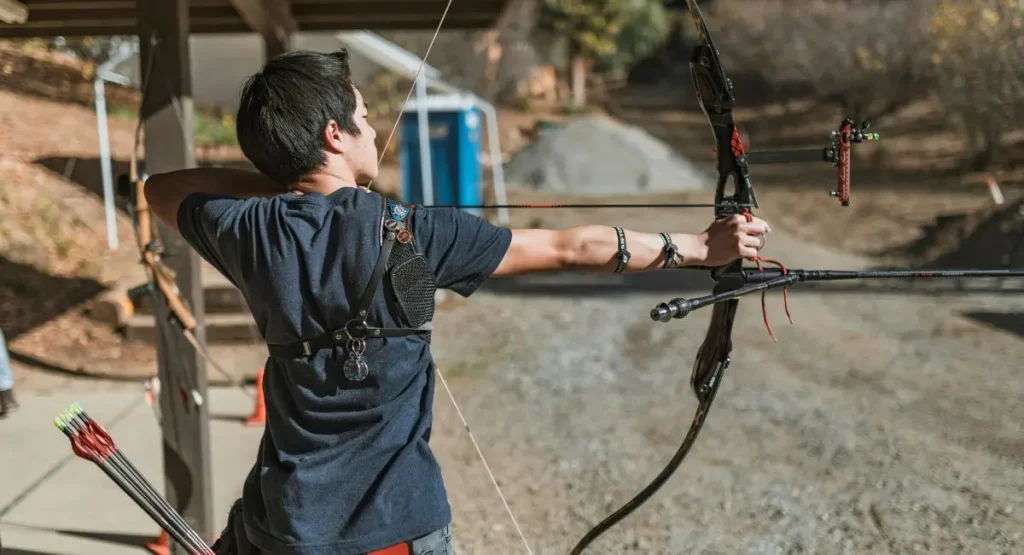
Mastering the basics is essential for any aspiring archer. Here are some fundamental techniques to get you started.
Proper Posture
A proper stance is the foundation of accurate shooting. Stand with your feet shoulder-width apart and perpendicular to the target. Distribute your weight evenly and maintain a relaxed posture.
Grip: Correct Way To Grip The Bow
How you hold your bow significantly affects your accuracy. Use a relaxed grip, allowing the bow to rest in the web between your thumb and index finger. Avoid gripping too tightly, as this can torque the bow.
Nocking The Arrow Step By Step Guide With Images
Nocking is the process of placing the arrow on the bowstring. Hold the arrow by the nock (the small notch on the end), and snap it onto the string just below the nocking point.
Drawing And Aiming
Drawing the bowstring involves pulling it back smoothly until your hand reaches your anchor point (a consistent spot on your face). Common mistakes include inconsistent anchor points and jerky movements.
Aiming Methods For Improving Accuracy
Focus on the target and align your sight or use instinctive aiming (relying on muscle memory). Consistent practice improves accuracy over time.
Releasing The Arrow Techniques For A Smooth Release
A smooth release is crucial to hitting your target. Relax your fingers and allow the string to slip off naturally. Avoid jerking or flinching during release.
The Importance Of Consistency
Consistency in your technique ensures accuracy. Practice regularly to develop muscle memory and maintain steady form.
Follow Through
Following through is the final step in your shot. Keep your bow arm steady and your release hand near your face. This helps maintain accuracy and ensures a clean shot.
Tips For Maintaining A Follow-Through
Focus on your target even after releasing the arrow. Practice holding your follow-through position to build muscle memory.
Advanced Techniques
Once you’ve mastered the basics, you can explore advanced techniques to enhance your skills.
Tips For Improving Accuracy And Consistency
Advanced archers use techniques like gap shooting (estimating the distance between the arrow and the target) and string walking (adjusting hand placement on the string) to improve accuracy.
Practicing Under Different Conditions
Practice in various weather conditions and terrains to adapt your skills. This prepares you for real-life scenarios, whether in competitions or outdoor adventures.
Safety And Maintenance
Safety and maintenance are paramount in archery. Here are some guidelines to keep you and your equipment in top shape.
Comprehensive Safety Guidelines For Archery Practice
Always shoot in a safe, designated area. Ensure no one is in the line of fire, and use appropriate backstops to catch stray arrows.
Maintenance Tips For Archery Equipment
Regularly check your bow, arrows, and other equipment for damage. Keep your bowstring waxed, and store your gear in a dry, cool place.
Common Safety Mistakes To Avoid
Avoid dry firing (shooting without an arrow), as it can damage your bow. Always inspect your equipment before use and follow safety protocols.
Expert Opinions And Credible Sources
When seeking archery guidance, expert opinions can provide invaluable insights into technique and training.
Renowned archery coach, Kurt Raschke, emphasizes the importance of a solid foundation:
Mastering your stance and grip is critical. These basic techniques directly affect your shot accuracy and consistency.
Flint F. Lee, a professional archer and educator, states,
It’s not just about hitting the target; it’s about understanding your equipment and developing a personal connection with your bow. Archers must find what works best for them.
Additionally, the Archery Trade Association offers comprehensive resources for archers at all levels, publishing guides on safety, maintenance, and technique. Their materials underline the importance of regular practice and proper equipment upkeep.
For those keen on furthering their skills, acclaimed books such as “The Art of Archery” by Erik E. H. Koller provide deep dives into advanced techniques and training methods, consolidating decades of expertise into accessible formats.
As noted by the National Archery in the Schools Program (NASP),
Archery teaches discipline, focus, and confidence, attributes that serve archers well both in the sport and in life.
These expert insights underscore the importance of skill, mindset and understanding for archery success.
Conclusion
Archery is a rewarding sport that offers physical, mental, and emotional benefits. By mastering the basics and exploring advanced techniques, you can enjoy this timeless activity to its fullest. Remember, consistency and practice are crucial. If you’re looking to improve your skills, consider joining an archery club or community. Happy shooting!
Frequently Asked Questions (FAQs)
How To Use Archery Step By Step?
Start with a proper stance, grip the bow correctly, nock the arrow, draw the bowstring, aim, and release the arrow smoothly. Maintain follow-through for better accuracy.
How Do You Hold A Bow And Arrow For Beginners?
Hold the bow with a relaxed grip, letting it rest in the web between your thumb and index finger. Nock the arrow onto the bowstring just below the nocking point.
What Are The Rules Of Bow And Arrow?
Always shoot in a safe, designated area, inspect your equipment before use, and follow proper safety protocols. Avoid dry firing, and ensure no one is in the firing line.
How To Shoot A Bow And An Arrow Better?
Focus on consistency in your technique, practice regularly, and pay attention to advanced techniques like gap shooting and string walking.
How To Shoot A Beginner’s Bow?
Start with a recurve bow or a basic compound bow. Follow the steps for proper stance, grip, nocking, drawing, aiming, releasing, and follow-through.
References
- National Archery Association (NAA) : NAA Website
- Archery Trade Association (ATA) : ATA Website
- “The Archery Bible” by Eric W. N. Chan
- “Archery: The Ultimate Guide to Archery in 2023” by Simon & Jordan Stone
- Archery 360 : Archery 360 Resource
- YouTube – National Archery in the Schools Program (NASP) : NASP YouTube Channel
- Archery Talk : Archery Talk Forum
Recommended Article
- The Ultimate Guide To Choosing Between Compound Bow vs Crossbow
- How To Carry A Bow – Tips & Techniques For Archers
- Ultimate Guide To Installing Compound Bow Arrow Rest
- The Ultimate Guide To The Best Archery Brands Of Compound Bows
- How To Utilize Recurve Bow Sights: A Comprehensive Guide
- The Archer’s Craft: Understanding Parts Of Recurve Bow

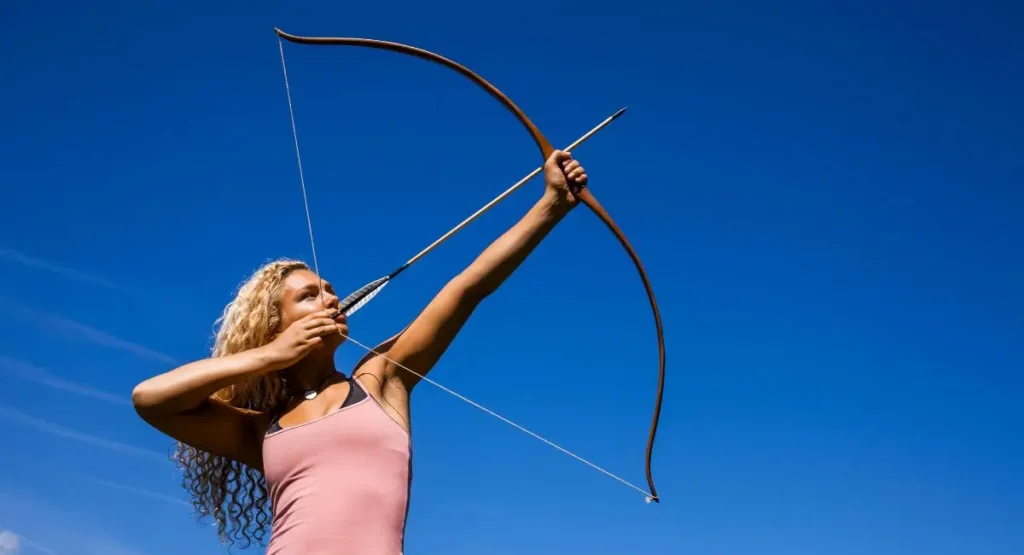

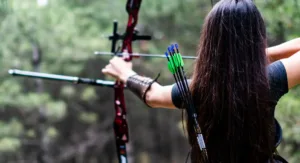
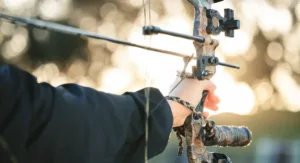

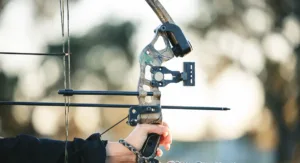
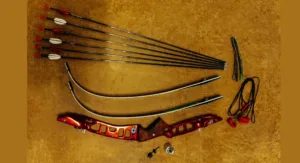
2 thoughts on “Mastering The Bow And Arrow: The Fun And Easy Guide For Beginners”
Comments are closed.